Does India need new coal-mines to meet demand?

Does India need new coal-mines to meet demand?
New Delhi: The recent announcement by the Central Government to auction coal blocks to private companies for commercial use of coal gathered mixed reactions from various stakeholders. Some called it a long awaited major reform. However, State governments of Jharkhand, Chhattisgarh and Maharashtra opposed the auction by either registering their concern via a letter or a legal challenge. Coal miners unions opposed privatisation fearing negative impact on Coal India Limited (CIL).
According to a report by Nandikesh Sivalingam, Director of Centre for Research on Energy and Clean Air (CREA), an independent research organisation focused on revealing the trends, causes, and health impacts, as well as the solutions to air pollution, and analyst Sunil Dahiya, environmentalists and human rights groups raised concerns that expansion of coal mining could lead to destruction of more than thousands of hectares of forest land and displacement of indigenous people in the last remaining contiguous forest of India.
The main reason highlighted while putting these blocks for auction is the “need for expansion in domestic coal mining capacity to meet the increasing demand and reduce import dependence of the country”.
Given that the country is reeling under economic distress for more than a year and COVID 19 situation has made it more difficult. Any reduction in import of coal into India would help to ease the pressure on the exchequer. However, it is important to review if coal mine expansion is the best way to jump start the economy.
To understand the argument better let’s try to look at different coal demand projections by coal India Limited and Central Electricity Authority.
Does India need new coal-mines to meet demand?
According to Coal Vision 2030, produced by CIL in 2017, total coal demand in India in 2020 is expected to be at 900–1,000 MTPA (Million Tons Per Annum) and 1,300–1,900 MTPA by 2030. The upper end of the spectrum of the coal demand corresponds to a GDP growth rate of 8 per cent. The lower end of the spectrum of the coal demand corresponds to an energy efficient scenario. The document also mentioned that the overall thermal coal demand in 2030 is estimated to be 1,150–1,750MTPA and the balance is coking coal demand.
The report further notes that the total capacity of mines allocated/ auctioned (including Coal India Limited, Singareni Collieries Company Limited and Neyveli Lignite Corporation) as on 2017 is about 1,500 MTPA at the current rated capacity. In view of the likely demand (base case scenario), there is limited requirement of starting new coal mines except the ones already auctioned/ allocated.
Further, Coal Production and imports for FY 2018-19 were 964 MT and coal offtake stood at 911 MT compared to that coal production by CIL has fallen for the first time in last two decades, it is expected that the overall coal offtake remained flat for FY 20.
Another report released by the Central Electricity Authority (CEA), Optimal Generation Capacity Mix 2029-30 mentioned, “The Gross Generation from coal power plants is estimated to be 1358 BU 3 for the year 2029-30. The coal requirement for the year 2029-30 has been worked out to be about 4 892 Million Tonnes considering specific coal 0.65kg/kWh + 1% transportation loss.”
Does India need new coal-mines to meet demand?
The Coal Vision 2030 also notes that “The power sector remains the key consumer segment with nearly 70 percent of the overall coal demand.” The document further adds that, “the estimated growth in coal demand from non-regulated sector at ~6% CAGR (compound annual growth rate) up to 2030 is higher than the estimated demand growth in the regulated sector (~3% CAGR). However, the regulated sector will continue to be the largest coal consumer with a two-third contribution.”
Based on the above numbers it is evident that total coal requirement in FY 2029-30 is going to be in the range of 1188 to 1273 Million Tonnes (MT).
The coal demand calculated above falls under 1300 MT which is also similar to the coal demand expected under Optimal Generation Capacity Mix 2020-30 by CEA under most feasible scenario.
As per the coal mines allocated to Coal India Limited, to Singareni Collieries Company Limited and other entities including captive coal blocks, India currently has a capacity of above 1500 MT, So the minable capacity of already allocated blocks is around 15 to 20% higher than the expected demand in 2030. This raises a question on the further need to allocate or auction new coal blocks.
Does India need new coal-mines to meet demand?
CIL’s current production stands at 602 MT for FY 2019-20 against the minable capacity of around one Billion Tonnes (BT), if CIL’s production increases by 5% year on year for next 10 years, India will have ~400 MT extra coal from CIL along with another 500 MT capacity with state and private entities which stands at around 60 MT in FY 2019-20, this quantum is more than sufficient to meet coal demand growth in India while replacing the import dependence over next decade.
So from the above projections its clear that India already has more than enough reserves to be mined till 2030 and if CIL, other PSUs, captive private and the private commercial coal mining, all of them increase their coal outputs in the next three to five years, the coal mining sector would face a massive oversupply situation.
The estimates presented above are under a conservative scenario as the actual electricity demand is less than the expected electricity demand under 19th Electric Power Survey (EPS 19) which is used as base for coal demand calculation for 2029-30 and the past three years data reflects that the projections in EPS19 are overstated compared to actual demand in FY 2018-19 & 2019-20 as depicted in the table below. This over projection of demand in EPS19 might lead to further reduction in actual coal consumption in 2029-30.
Given the uncertainties with the economy and the disruption in the electricity sector that’s currently underway due to COVID 19 and the rapid growth in cheap renewable energy, there is a possibility of stranded assets in the coal mining sector similar to that of the private power sector.
Does India need new coal-mines to meet demand?
Given that the auctioned coal blocks would take three to five years to produce full capacity, it is safe to estimate that Coal India Limited (CIL) would also reach the one billion target production around the same time. Hence creating a massive oversupply of coal to the tune of 100 – 200million MT by the year 2025 even if the production from state PSU and other private coal mines would remain the same.
Even if we assume that CIL would only reach 800million MT by 2024-25, The country can easily increase production from already allotted/auctioned coal blocks for the additional coal requirement.
The only way coal auctions could be profitable, is if there was an implicit understanding that existing coal blocks are unable to produce enough coal in the near future. If this is true, then there is a case to be made for setting realistic targets and signing realistic fuel supply agreements (FSA) by CIL and other allottees. Furthermore, allocated blocks which can not be developed would also need to be deallocated.
The argument of exporting coal to other markets also is also questionable since Indian coal would not be able to compete against high quality coal from Indonesia. The current price of coal is around $50/ton, close to the average cost at which CIL sells its coal. However due to the fact that Indian coal has less heat value, it would need twice as much coal to produce the same amount of energy that imported coal could produce in much less. Making return on investment from Indian coal less appealing to neighbouring countries. Moreover, demand for coal has been declining since the pandemic and is likely to decline further due to coal phaseout policies in Japan and North Korea. Given the crash in international coal prices and low quality of Indian coal, there may not be any market for Indian coal.
Reducing coal imports and increasing self-reliance is a good objective, but perhaps these objectives could be achieved without sacrificing thousands of hectares of forest land and displacement of indigenous people. According to the government’s own projections and cumulative capacity of existing coal mines, India does not need new coal mines.
Does India need new coal-mines to meet demand?
Coal Vision 2030: A study commissioned by Coal India Limited (CIL) to assess the future demand scenarios for the coal sector in India (up to 2030) and identify other material developments. This study is an attempt to formulate a vision statement for the coal sector detailing the future evolution and identify key actions.
Optimal Generation Capacity Mix 2029-30: The study is an exercise to assess the least cost generation capacity mix to meet the projected Electricity Demand for the year 2029-30.




